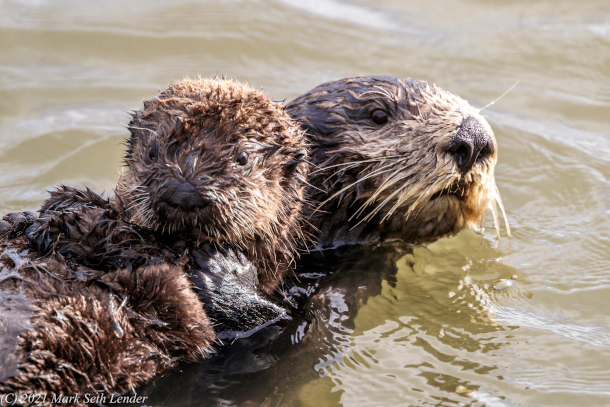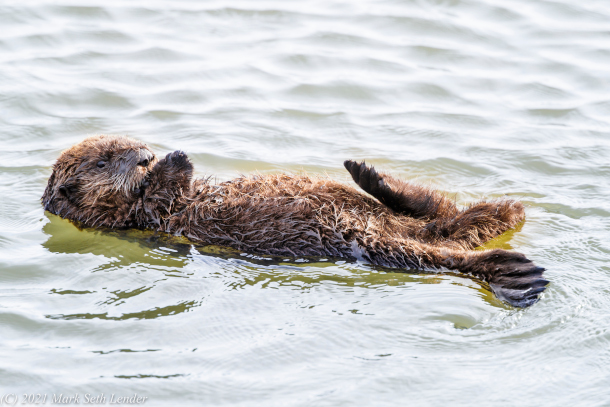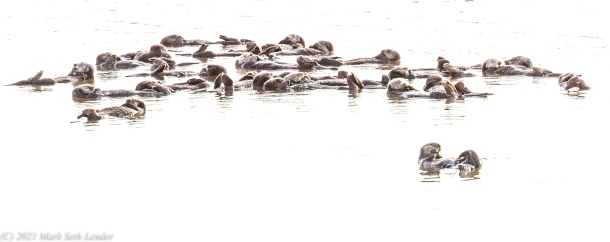Mother and Son: Sea Otter Bonding
Air Date: Week of July 9, 2021

Sea otters give birth in the water and can spend their whole lives without ever leaving the water. To care for her young, a mother sea otter places her newborn on her belly, grooming it from head to tail. (Photo: (c) Mark Seth Lender)
Mother sea otters spend a lot of time grooming their young pups. It’s a bonding experience as well as a matter of survival. Clean and well-groomed fur keeps these sea otters afloat on the coastal waters where they spend their entire lives. Living on Earth’s Explorer-in-Residence Mark Seth Lender narrates a precious scene of an attentive otter mom and her young pup.
Transcript
BASCOMB: Oysters and other shellfish can be a staple food for many marine species including sea otters. Living On Earth’s Explorer in Residence Mark Seth Lender has our story.
Mother and Son
Southern Sea Otter
Elkhorn Slough, Monterey Bay
© 2021 Mark Seth Lender
All Rights Reserved
In the narrowed channel, slack tide, a mat of kelp or weed or salt grass floats along, without a notion of its own, captured by the absent-minded tug and turn of eddies at slack tide between the sand bars. It drifts, closer. Then shifts, further. Catching in a spiral of water turning, turning until…
Recognition!
Mother and Son Sea Otter!

The sea otter has the thickest fur of any animal. Such dense fur allows for insulating pockets of air, keeping them warm and helping them stay afloat as they lie on their backs. When ungroomed, dirty hairs will clump together, losing captured air, so grooming is a matter of survival. (Photo: (c) Mark Seth Lender)
The baby is newborn, one week, maybe two. Round and wet, unable to fend for himself. Cannot care for himself. His mother washing, scrubbing, rubbing, combing every inch of him. And when she finishes one end, working from the long spiky fur of his tail, she turns him on the Lazy Susan of her belly and starts all over the opposite way, from his sweet wet face on down. He opens his eyes. He has a sleepy look. She props him up on a cushion of water and dives, and comes back with a clam she breaks open and divides but does not share with him.
He is too young. But soon…

When they are not foraging or grooming, sea otters are often resting. To keep themselves from drifting out to sea, they will wrap themselves in kelp and hold on to each other as they snooze. This group of resting sea otters is called a “raft.” (Photo: (c) Mark Seth Lender)
Then sea clam will be food to him, the taste he will follow all his life. When he is older and stronger and heavy enough he will learn to follow her down and down to the cloudy bottom, and recognize the shapes and smells and take a stone and crack the shell. There will be a lot to learn. He is lucky. She will as mother otters do take the time to teach him.
As much, and as long, as he needs.
BASCOMB: That’s Living on Earth’s Explorer in Residence Mark Seth Lender.
Links
Read Mark's Field Note for this essay
Learn more about author and photographer Mark Seth Lender’s work
All you need to know about sea otters!
Special thanks this week to Kayak Connection of Moss Landing, CA
Living on Earth wants to hear from you!
Living on Earth
62 Calef Highway, Suite 212
Lee, NH 03861
Telephone: 617-287-4121
E-mail: comments@loe.org
Newsletter [Click here]
Donate to Living on Earth!
Living on Earth is an independent media program and relies entirely on contributions from listeners and institutions supporting public service. Please donate now to preserve an independent environmental voice.
NewsletterLiving on Earth offers a weekly delivery of the show's rundown to your mailbox. Sign up for our newsletter today!
 Sailors For The Sea: Be the change you want to sea.
Sailors For The Sea: Be the change you want to sea.
 The Grantham Foundation for the Protection of the Environment: Committed to protecting and improving the health of the global environment.
The Grantham Foundation for the Protection of the Environment: Committed to protecting and improving the health of the global environment.
 Contribute to Living on Earth and receive, as our gift to you, an archival print of one of Mark Seth Lender's extraordinary wildlife photographs. Follow the link to see Mark's current collection of photographs.
Contribute to Living on Earth and receive, as our gift to you, an archival print of one of Mark Seth Lender's extraordinary wildlife photographs. Follow the link to see Mark's current collection of photographs.
 Buy a signed copy of Mark Seth Lender's book Smeagull the Seagull & support Living on Earth
Buy a signed copy of Mark Seth Lender's book Smeagull the Seagull & support Living on Earth

